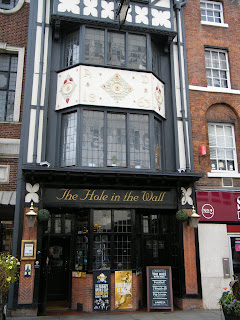Although nothing of the original Anglo-Saxon buildings have survived, the name itself was recorded as early as 1016, as Scrobbesbyrig (possibly meaning the fortified place of a district called The Scrub). The Normans found it hard to say ‘scr’ and changed it to ‘sr’ and then ‘sar’ which got confused with ‘Sal’ so that it became ‘Salopesberie' (the abbreviation of Shropshire is still ‘Salop’ to this day). An English form persisted, though, in 'Shrobesbury'. This had changed to 'Shrouesbury' by 1346. But towards the end of the century, ‘Shrew’ spellings appeared, such as 'Shrewesbury' in 1386, which alternated with 'Shrow' spellings thereafter. The two spellings appear to have been equally acceptable, and thus the argument over pronunciation began.*
 |
| The stone head of Roger de Montgomery |
However you say the name, there is no disputing that the town is stunning, with much architectural merit. The original Norman castle and abbey were built by Roger de Montgomery after the Conquest in around 1080 but the castle which stands today is a rebuild from the twelfth century. (The abbey was the setting for the Brother Cadfael novels by Ellis Peters.)
Although nothing much survives of the building pre- and immediately post-Conquest, the medieval streets are much in evidence as in, for example, Grope Lane, where the building almost kiss each other above street level.
And yes, much worse probably went on at ground level, hence the name! At the top of Grope Lane is the Bear Steps Gallery, in a building which was a - possibly - fifteenth-century hall although dendrochronology has produced frustrating results, with not all the timbers being dateable. This is also a reminder that not all these ancient buildings have, or would have, survived. In the mid-twentieth century, the buildings collectively known as the Bear Steps had become a group of barely habitable, run down cottages, which were condemned. The buildings would have been demolished had the Civic Society not raised the money necessary for the renovation and restoration.
Only the Lady Chapel remains of St Chad’s, which was the largest of the town’s medieval churches. St Alkmund was a revered Mercian saint, and the church dedicated to him in Shrewsbury was founded during the ‘reign’ of Æthelflæd, Lady of the Mercians.
 |
| St Alkmund's Spire |
The tower and spire though date from 1475 and the chancel and nave were rebuilt in 1795. St Mary’s, nearby, is intact from the medieval era, with the earliest sections built from 1170 onwards with stone from the nearby Roman city of Wroxeter. St Mary’s is where I found some Anglo-Saxon grave markers. Phil, from the town’s museum, had sent me to look at what are the only Anglo-Saxon bits of Shrewsbury visible to the general public. ** St Mary’s is also famous for the fourteenth-century stained glass ‘Jesse’ window, which depicts Christ's family tree.
 |
| Anglo-Saxon Grave Markers |
An interesting building is the ‘Hole in the Wall’. This building started life as a family home in the thirteenth century and has been a pub - the Gullet Inn - and, in its time, also a slaughterhouse and a debtors’ prison. It is said that the original ‘hole’ was where the prisoners were kept, in a single cell. It is rumoured that these souls are still there, trying to get free… The family who owned the original building were the Schitte family.
The Schittes appeared first appeared in the town records in 1219. And yes, the name probably suggests that they were involved in the unpleasant but necessary business of removing night soil in the town. Still, it seems that they outgrew their lowly origins and later records show that they became high class cutlers, which, although the name suggests the manufacture of cutlery, may at this time have involved the making of swords. (The word cutler derives from French and means ‘maker of knives’.)
 |
| How the original 'Hole in the Wall' building might have looked |
Medieval guilds were, of course, powerful institutions and one of the leading guilds in Shrewsbury was that of the Drapers. They were responsible for the construction of many of the timbered houses in the town which still stand today, including Rowley’s House, a sixteenth-century edifice that used to be home to the town’s museum and art gallery and which is also supposed to be haunted.
 |
| Rowley's House |
The Henry VII pub promises free hugs (alas, not free beer!) and also boasts of fourteenth-century art. Sadly, it was shut when I arrived so I couldn’t investigate whether this art was in the form of murals, or something else. Note how much the building leans though!
Shrewsbury is famous for its medieval origins and its strategic importance - the bridges in/out of the town are relatively modern but crossings have existed since at least Norman times - and of course for the bloody battle of 1403, but it has other, more modern, claims to fame.
The Methodist, John Wesley, preached in the town in 1761 and he was there to witness the opening of the first Methodist chapel in Shrewsbury. Perhaps the town’s most famous son was Charles Darwin, author of On the Origin of Species. He was born at Mount House and attended Shrewsbury School.
AE Houseman wrote about the town in A Shropshire Lad. As I've already mentioned, Ellis Peters set her Brother Cadfael books there. Another literary connection is that of Wilfred Owen, the WWI poet whose most famous work is probably Dulce et Decorum Est. I was informed that his mother received the news of his death while the local church bells were ringing to celebrate the end of the war. Such tragic timing.
If you find yourself in the area, a good starting point would be the museum and gallery, where you can learn about the history of the area from Roman times, through the Medieval Gallery and beyond to the Tudor and Stuart periods. I recommend a visit; you won’t be disappointed.
*See Margaret Gelling, Signposts to the Past, pp 28-9
** He told me that an Anglo-Saxon cellar has been excavated, but it is in a private house and not open to the public.
[all photographs by the author]
This article originally appeared on the EHFA (English Historical Fiction Authors) blog on 15 September 2019
See my follow up post there on the bloody Battle of Shrewsbury






















































